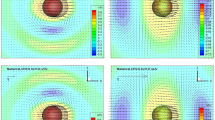Abstract
The dual reciprocity boundary element method (DR/BEM) is employed for the analysis of free and forced vibrations of three-dimensional elastic solids. Use of the elastostatic fundamental solution in the integral formulation of elastodynamics creates an inertial volume integral in addition to the boundary ones. This volume integral is transformed into a surface integral by invoking the reciprocal theorem. A general analytical method is described for the closed form determination of the particular solutions of the displacement and traction tensors corresponding to any radial basis function employed in the transformation process. The simple but effective 1+r radial basis function is used in the applications of this paper. Quadratic continuous and discontinuous 9-noded boundary elements are used in the analysis. Free vibrations are studied by solving the corresponding eigenvalue problem iteratively. Harmonic forced vibration problems are solved directly in the frequency domain. Transient forced vibration problems are solved by integrating the equations of motion stepwise with the aid of various algorithms. Interior collection points are also used for assessing the accuracy of the method. Two numerical examples involving free and forced vibrations of a sphere and a cube are presented in detail.
Similar content being viewed by others
Author information
Authors and Affiliations
Rights and permissions
About this article
Cite this article
Agnantiaris, J., Polyzos, D. & Beskos, D. Three-dimensional structural vibration analysis by the Dual Reciprocity BEM. Computational Mechanics 21, 372–381 (1998). https://doi.org/10.1007/s004660050314
Issue Date:
DOI: https://doi.org/10.1007/s004660050314




